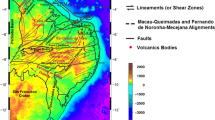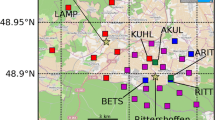Abstract
Ambient seismic noise has proven to be a particularly effective tool for subsurface imaging in the last decades, with applications ranging from near surface imaging, to crustal or upper mantle tomography. Fundamentally, it relies on the cross correlations of continuous recordings of ground motion data at pairs of seismic stations. Processing steps have become more refined and promising in extracting meaningful signals that can further be used in a range of classic seismology tools. The processing, however, is usually cumbersome, time- and memory-consuming, as it requires years of continuous noise recorded at broadband seismic stations, to obtain high signal-to-noise ratio empirical Green’s functions. In order to ease the research effort, we built a database of ambient seismic noise cross correlations between pairs of broadband seismic stations that operated in Central and Eastern Europe between 1999 and 2020. The database is part of the Eastern European Ambient Seismic Noise (EENSANE) research project hosted by the National Institute of Earth Physics in Romania and will progressively grow as more stations become available, such as those provided by the new AdriaArray network. Based on this database and using state-of-the-art inversion techniques, we developed a series of near-surface and crustal tomography models of the Eastern European craton, the Trans-European Suture Zone and younger accreted terranes from Central Europe. Our integrated models provide both isotropic and azimuthally anisotropic seismic velocities from surface wave dispersion and attenuation parameters from the decay envelopes of Rayleigh waves. Using horizontal-to-vertical ratios of ambient noise, we also recovered the fundamental frequency of resonance and near surface shear wave velocity models beneath stations located across the Carpathian Orogen. Based on cross-correlation functions, we were also able to retrieve the seismic wavefield and peak ground displacement amplitudes from past earthquakes decades after their occurrence, offering a chance for improving seismic hazard and risk models in seismically vulnerable and developing regions of Europe. Our multidisciplinary results prove the versatility of ambient noise uses and the importance of the EENSANE database for a wide range of seismological imaging and hazard applications.






Similar content being viewed by others
Data availibility
The Supplementary Material contains tables of network and station details, their archiving centers and overlapping data periods. Access to raw seismic data was made using FDSN (International Federation of Digital Seismograph Networks) Web Services (https://www.fdsn.org/webservices/). Access to the ambient noise cross-correlation database and further results can be found on the project’s website (https://eensane.infp.ro/) and in the Mendeley data repository at https://data.mendeley.com/datasets/scr529r5bk/1. Most codes for processing ambient noise data are freely available: the continuous wavelet transform (https://github.com/SwiftHickory/bc_denoise.git, accessed Aug 2021), the ambient noise cross-correlation and automatic phase velocity dispersion analysis (https://github.com/ekaestle/amb_noise_tools, accessed Aug 2021), and the Markov-chain Monte Carlo surface wave inversion (https://github.com/jenndrei/BayHunter, accessed Sep 2021), modeling virtual earthquake wavefields (https://github.com/mdenolle/vea—accessed Feb 2022) and inverting HVSR curves (https://w3.ual.es/GruposInv/hv-inv/, accessed Aug 2022). Most figures were plotted with the GMT (Generic Mapping Tools) software (Wessel et al. 2013).
References
Bensen G, Ritzwoller M, Barmin M, Levshin AL, Lin F, Moschetti M, Shapiro N, Yang Y (2007) Processing seismic ambient noise data to obtain reliable broad-band surface wave dispersion measurements. Geophys J Int 169(3):1239–1260. https://doi.org/10.1111/j.1365-246X.2007.03374.x
Borleanu F, Petrescu L, Seghedi I, Thomas C, De Siena L (2023a) The seismic attenuation signature of collisional orogens and sedimentary basins within the Carpathian Orogen. Glob Planet Change 223:104093. https://doi.org/10.1016/j.gloplacha.2023.104093
Borleanu F, Petrescu L, Placinta AO, Magrini F, Grecu B, Radulian M, De Siena L (2023b) Seismic attenuation tomography of Eastern Europe from ambient seismic noise analysis. Geophys J Int. https://doi.org/10.1093/gji/ggad408
Coman A, Petrescu L (2023) Near-surface ambient-noise seismic tomography of Bucharest, Romania. Technical report, Copernicus Meetings. https://doi.org/10.5194/egusphere-egu23-14984
Coman A, Manea E, Cioflan C, Radulian M (2020) Interpreting the fundamental frequency of resonance for Transylvanian Basin. Rom J Phys 65:809
Curtis A, Gerstoft P, Sato H, Snieder R, Wapenaar K (2006) Seismic interferometry—turning noise into signal. Lead Edge 25(9):1082–1092. https://doi.org/10.1190/1.2349814
Dando B, Stuart G, Houseman G, Hegedüs E, Brückl E, Radovanović S (2011) Teleseismic tomography of the mantle in the Carpathian-Pannonian region of central Europe. Geophys J Int 186(1):11–31. https://doi.org/10.1111/j.1365-246X.2011.04998.x
De Siena L, Thomas C, Waite GP, Moran SC, Klemme S (2014) Attenuation and scattering tomography of the deep plumbing system of Mount St. Helens. J Geophys Res Solid Earth 119(11):8223–8238. https://doi.org/10.1002/2014JB011372
Denolle MA, Dunham EM, Beroza GC (2012) Solving the surface-wave eigenproblem with Chebyshev spectral collocation. Bull Seismol Soc Am 102(3):1214–1223. https://doi.org/10.1785/0120110183
Denolle M, Dunham E, Prieto G, Beroza G (2013) Ground motion prediction of realistic earthquake sources using the ambient seismic field. J Geophys Re Solid Earth 118(5):2102–2118. https://doi.org/10.1029/2012JB009603
Deschamps F, Lebedev S, Meier T, Trampert J (2008) Azimuthal anisotropy of Rayleigh-wave phase velocities in the east-central United States. Geophys J Int 173(3):827–843. https://doi.org/10.1111/j.1365-246X.2008.03751.x
Ekström G, Abers GA, Webb SC (2009) Determination of surface-wave phase velocities across USArray from noise and Aki’s spectral formulation. Geophys Res Lett. https://doi.org/10.1029/2009GL039131
Fäh D, Kind F, Giardini D (2003) Inversion of local S-wave velocity structures from average H/V ratios, and their use for the estimation of site-effects. J Seismol 7:449–467. https://doi.org/10.1023/B:JOSE.0000005712.86058.42
García-Jerez A, Navarro M, Alcalá F, Luzón F, Pérez-Ruiz J, Enomoto T, Vidal F, Ocaña E (2007) Shallow velocity structure using joint inversion of array and h/v spectral ratio of ambient noise: the case of Mula town (SE of Spain). Soil Dyn Earthq Eng 27(10):907–919. https://doi.org/10.1016/j.soildyn.2007.03.001
García-Jerez A, Piña-Flores J, Sánchez-Sesma FJ, Luzón F, Perton M (2016) A computer code for forward calculation and inversion of the H/V spectral ratio under the diffuse field assumption. Comput Geosci 97:67–78. https://doi.org/10.1016/j.cageo.2016.06.016
Heidbach O, Rajabi M, Cui X, Fuchs K, Müller B, Reinecker J, Reiter K, Tingay M, Wenzel F, Xie F et al (2018) The World Stress Map database release 2016: crustal stress pattern across scales. Tectonophysics 744:484–498. https://doi.org/10.1016/j.tecto.2018.07.007
Herrmann RB (2013) Computer programs in seismology: an evolving tool for instruction and research. Seismol Res Lett 84(6):1081–1088. https://doi.org/10.1785/0220110096
Kästle ED, Soomro R, Weemstra C, Boschi L, Meier T (2016) Two-receiver measurements of phase velocity: cross-validation of ambient-noise and earthquake-based observations. Geophys J Int 207(3):1493–1512. https://doi.org/10.1093/gji/ggw341
Kováč M, Andreyeva-Grigorovich A, Bajraktarević Z, Brzobohatỳ R, Filipescu S, Fodor L, Harzhauser M, Nagymarosy A, Oszczypko N, Pavelić D et al (2007) Badenian evolution of the Central Paratethys Sea: paleogeography, climate and eustatic sea-level changes. Geol Carpathica 58(6):579–606
Li S, Huang J, Liu Z, Zhang Y (2019) Study on the mantle discontinuity structures beneath Northeast China with time-frequency phase-weighted stacks of ambient noise correlations. Geophys J Int 218(3):1490–1501. https://doi.org/10.1093/gji/ggz235
Magrini F, Boschi L (2021) Surface-wave attenuation from seismic ambient noise: numerical validation and application. J Geophys Res Solid Earth 126(1):2020–019865. https://doi.org/10.1029/2020JB019865
Martin M, Ritter J, Group CW (2005) High-resolution teleseismic body-wave tomography beneath SE Romania-I. Implications for three-dimensional versus one-dimensional crustal correction strategies with a new crustal velocity model. Geophys J Int 162(2):448–460. https://doi.org/10.1111/j.1365-246X.2005.02661.x
Molinari I, Obermann A, Kissling E, Hetényi G, Boschi L, Group A-EW et al (2020) 3D crustal structure of the Eastern Alpine region from ambient noise tomography. Results Geophys Sci 1, 100006 (2020). https://doi.org/10.1016/j.ringps.2020.100006
Petrescu L, Borleanu F, Placinta A (2021) The EENSANE project: an open-source database of ambient noise cross correlations and virtual earthquake simulations in Europe. In: AGU fall meeting abstracts, vol 2021, pp 35–0222. https://doi.org/2021AGUFM.S35B0222P
Petrescu L, Borleanu F, Placinta AO (2022) Seismic structure of a Tethyan back-arc: transdimensional ambient noise tomography of the Black Sea lithosphere. Phys Earth Planet Inter 325:106854. https://doi.org/10.1016/j.pepi.2022.106854
Petrescu L, Popa M, Radulian M (2023a) Shallow seismic structure around the Vrancea Seismic Zone from joint inversion of ambient noise H/V ratios and surface wave dispersion. Tectonophysics 859:229897. https://doi.org/10.1016/j.tecto.2023.229897
Petrescu L, Placinta AO, Borleanu F, Radulian M, Cioflan C (2023b) Past earthquake simulations using ambient seismic noise in Vrancea, Romania. Seismol Res Lett. https://doi.org/10.1785/0220230072
Petrescu L, Borleanu F, Kastle E, Stephenson R, Placinta AO, Liashchuk OI (2024) Seismic structure of the Eastern European crust and upper mantle from probabilistic ambient noise tomography. Gondwana Res 125:390–405. https://doi.org/10.1016/j.gr.2023.08.022
Popa M, Radulian M, Ghica D, Neagoe C, Nastase E (2015) Romanian Seismic Network since 1980 to the present. In: Nonlinear mathematical physics and natural hazards: selected papers from the international school and workshop held in Sofia, Bulgaria, 28 November–02 December, 2013. Springer, pp 117–131 (2015). https://doi.org/10.1007/978-3-319-14328-6_9
Radulian M, Bălă A, Ardeleanu L, Toma-Dănilă D, Petrescu L, Popescu E (2019) Revised catalogue of earthquake mechanisms for the events occurred in Romania until the end of twentieth century: REFMC. Acta Geod Geophys 54:3–18. https://doi.org/10.1007/s40328-018-0243-y
Ren Y, Stuart G, Houseman G, Dando B, Ionescu C, Hegedüs E, Radovanović S, Shen Y, Group SCPW et al (2012) Upper mantle structures beneath the Carpathian-Pannonian region: implications for the geodynamics of continental collision. Earth Planet Sci Lett 349:139–152. https://doi.org/10.1016/j.epsl.2012.06.037
Ren Y, Grecu B, Stuart G, Houseman G, Hegedüs E, Group SCPW (2013) Crustal structure of the Carpathian–Pannonian region from ambient noise tomography. Geophys J Int 195(2):1351–1369. https://doi.org/10.1093/gji/ggt316
Retailleau L, Boué P, Li L, Campillo M (2020) Ambient seismic noise imaging of the lowermost mantle beneath the North Atlantic Ocean. Geophys J Int 222(2):1339–1351. https://doi.org/10.1093/gji/ggaa210
Scherbaum F, Hinzen K-G, Ohrnberger M (2003) Determination of shallow shear wave velocity profiles in the Cologne, Germany area using ambient vibrations. Geophys J Int 152(3):597–612. https://doi.org/10.1046/j.1365-246X.2003.01856.x
Soergel D, Pedersen HA, Stehly L, Margerin L, Paul A, Group AW (2020) Coda-Q in the 2.5–20 s period band from seismic noise: application to the greater Alpine area. Geophys J Int 220(1):202–217. https://doi.org/10.1093/gji/ggz443
Szanyi G, Gráczer Z, Győri E (2013) Ambient seismic noise Rayleigh wave tomography for the Pannonian basin. Acta Geod Geophys 48(2):209–220. https://doi.org/10.1007/s40328-013-0019-3
Wessel P, Smith WH, Scharroo R, Luis J, Wobbe F (2013) Generic mapping tools: improved version released. Eos Trans Am Geophys Union 94(45):409–410. https://doi.org/10.1002/2013EO450001
Wilde-Piorko M, Geissler W, Plomerová J, Grad M, Babuska V, Brückl E, Cyziene J, Czuba W, England R, Gaczyski E et al (2008) PASSEQ 2006–2008: passive seismic experiment in Trans-European Suture Zone. Studia Geophys Geod 52(3):439. https://doi.org/10.1007/s11200-008-0030-2
Yang Y, Liu C, Langston CA (2020) Processing seismic ambient noise data with the continuous wavelet transform to obtain reliable empirical Green’s functions. Geophys J Int 222(2):1224–1235. https://doi.org/10.1093/gji/ggaa243
Acknowledgements
We thank Emanuel Kastle for making their ambient noise processing codes available and for providing help with their usage. We are also grateful to Oleksandr Ivanovich Liashchuk for providing data for some stations operated by the Main Center of the Special Monitoring of Ukraine which greatly improved the seismic velocity model resolution in the East European Craton. We thank two anonymous reviewers and Editor György Hetényi for constructive comments that served to improve the original manuscript.
Funding
The present study was funded by the EENSANE (East European Ambient Seismic Noise https://eensane.infp.ro/) Project PN-III-P4-ID- PCE-2020-2972 supported by UEFISCDI (Executive Agency for Higher Education, Research, Development and Innovation Funding), Romania.
Author information
Authors and Affiliations
Contributions
LP was responsible for initial funding acquisition, formal analysis, visualisation of results and writing of the original manuscript. AP helped with data curation and analysis and original manuscript writing. FB helped with results visualisation, formal analysis, methodology, software, and manuscript writing and editing. AM, MR, and MP carried out routine data analysis and manuscript editing. AC and CC contributed to manuscript review.
Corresponding author
Ethics declarations
Conflict of interest
The authors declare that they have no competing interests.
Ethics approval and consent to participate
Not applicable.
Consent for publication
Not applicable.
Rights and permissions
Springer Nature or its licensor (e.g. a society or other partner) holds exclusive rights to this article under a publishing agreement with the author(s) or other rightsholder(s); author self-archiving of the accepted manuscript version of this article is solely governed by the terms of such publishing agreement and applicable law.
About this article
Cite this article
Petrescu, L., Plăcintă, A.O., Borleanu, F. et al. The EENSANE (Eastern European Seismic Ambient Noise) project: providing a new free database of ambient noise cross-correlations and crustal seismic models in the Carpathian-Pannonian Region and beyond. Acta Geod Geophys (2024). https://doi.org/10.1007/s40328-024-00438-x
Received:
Accepted:
Published:
DOI: https://doi.org/10.1007/s40328-024-00438-x




